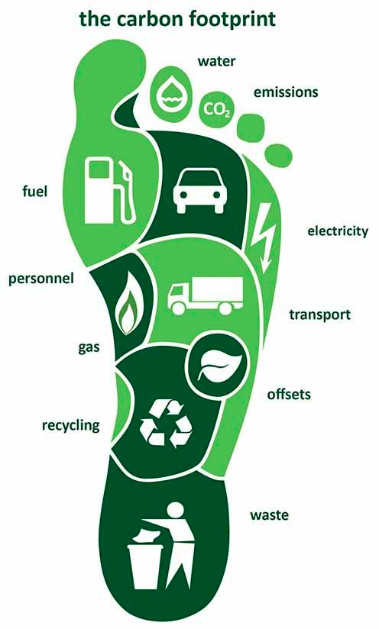To Know More?
CLIMATE CHANGE
 The demand for products and energy has contributed to significant increases in product offerings and consumption of natural resources. This results in the generation of carbon dioxide emissions into the atmosphere. Carbon dioxide, one of the Greenhouse Gases produced by human activities, is responsible for most of the "thickening of the blanket" that trap heat near the surface of earth and cause climate change.
The demand for products and energy has contributed to significant increases in product offerings and consumption of natural resources. This results in the generation of carbon dioxide emissions into the atmosphere. Carbon dioxide, one of the Greenhouse Gases produced by human activities, is responsible for most of the "thickening of the blanket" that trap heat near the surface of earth and cause climate change.What is the Greenhouse Effect?
 The Earth gets energy from the sun in the form of sunlight. The Earth's surface absorbs some of this energy and heats up. That's why the surface of a road feels hot even after the sun disappears because it has already absorbed a lot of energy from the sun. The Earth cools down by giving off a different form of energy, called infrared radiation. But before all these radiation can escape to outer space, greenhouse gases in the atmosphere absorb some of it, which makes the atmosphere warmer. As the atmosphere gets warmer, it makes the Earth's surface warmer, too.
The Earth gets energy from the sun in the form of sunlight. The Earth's surface absorbs some of this energy and heats up. That's why the surface of a road feels hot even after the sun disappears because it has already absorbed a lot of energy from the sun. The Earth cools down by giving off a different form of energy, called infrared radiation. But before all these radiation can escape to outer space, greenhouse gases in the atmosphere absorb some of it, which makes the atmosphere warmer. As the atmosphere gets warmer, it makes the Earth's surface warmer, too.What is the Greenhouse Gas Footprint or Carbon Footprint?
 A Greenhouse Gas (GHG) footprint is a measure of the GHG emissions that an individual or company emits from his / its business-as-usual operation or activity. These emissions often transpire from activities that require combustion of fuel and electricity as well as use of paper. The following sources are generally considered for GHG calculation:
A Greenhouse Gas (GHG) footprint is a measure of the GHG emissions that an individual or company emits from his / its business-as-usual operation or activity. These emissions often transpire from activities that require combustion of fuel and electricity as well as use of paper. The following sources are generally considered for GHG calculation: - Energy consumption / electricity used
- Fuel used for heating and power generation to offset electricity shortfall
- Fuel used for ground transport, such as corporate fleet of cars
- Fuel used for air travel
- Consumption of paper products
- Refrigerant gases used
In order to reduce the GHG emissions, countries are promoting the usage of energy in an efficient way, or green energy sources (PV, Solar Water Heaters, Wind Turbines...) to produce electricity, using biking or buses to go to work and come back, using board instead of paper, and cooling of the house naturally, instead of using AC.
What is the Difference between Climate and Weather?
 Climate change is different than daily weather changes. Weather happens at a particular time and place. Rain, snow, wind, hurricanes, tornadoes these are all weather events. Climate refers to the average weather conditions in a certain place over many years. Global climate is the average climate over the entire planet.
Climate change is different than daily weather changes. Weather happens at a particular time and place. Rain, snow, wind, hurricanes, tornadoes these are all weather events. Climate refers to the average weather conditions in a certain place over many years. Global climate is the average climate over the entire planet.When scientists talk about global climate change, they're talking about the pattern of change that's happening over many years. One of the most important trends that scientists look at is the average temperature of the Earth, which has been increasing for many years. This is called global warming.
Rising global temperatures lead to hurricanes, melting glaciers, and the loss of wildlife habitats. That's because the Earth's air, water, and land are all related to one another and to the climate. This means a change in one place can lead to other changes somewhere else.
What are the Impacts of Climate Change?
The Earth's climate is getting warmer, and the signs are everywhere. Rain patterns are changing, sea level is rising, and snow and ice are melting sooner in the spring. As global temperatures continue to rise, we'll see more changes in our climate and our environment. Global climate change will affect people and the environment in many ways. Some of these impacts, like stronger hurricanes and severe heat waves, could be life threatening.
The negative impacts of global climate change will be less severe overall if people reduce the amount of greenhouse gases we're putting into the atmosphere and worse if we continue producing these gases at current or faster rates.
The negative impacts of global climate change will be less severe overall if people reduce the amount of greenhouse gases we're putting into the atmosphere and worse if we continue producing these gases at current or faster rates.
